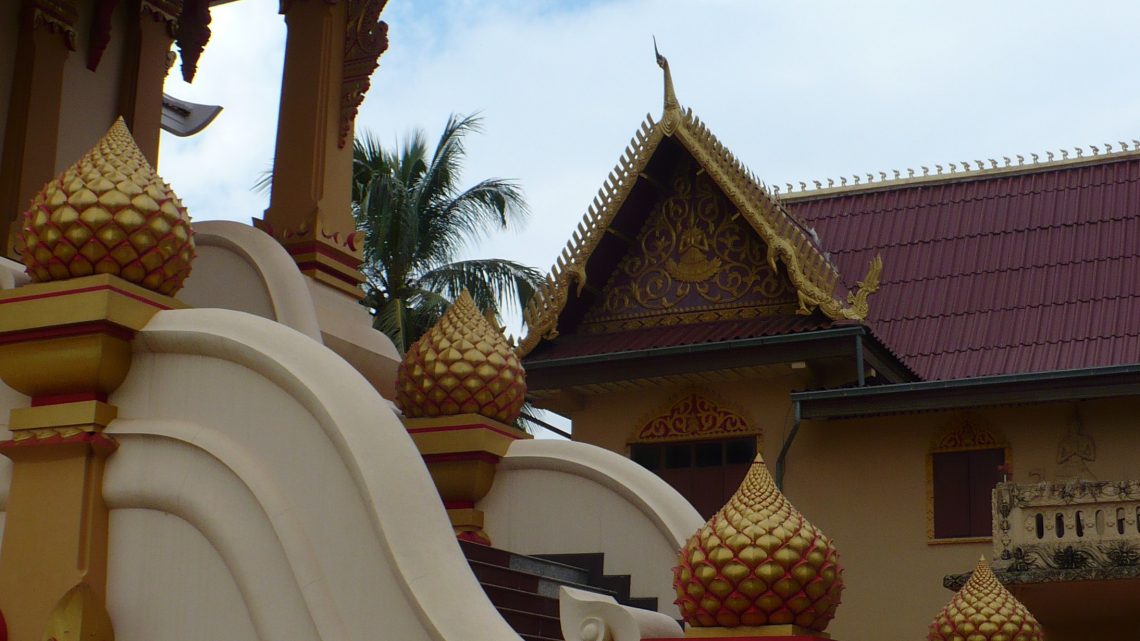Since our daughter, Kelti, is teaching at a school in Laos we decided to spend our holiday visiting her. It was an amazing experience for our family since we had never traveled to an Asian country before. This set of blogs describes our adventures and lessons from them I want to remember.
Of Monks and Missions
Almost every home and business in Vientiane has a shrine in the courtyard. Most are replicas of famous temples, built on pedestals so they are about chest-high to the people who maintain them. There was one in the courtyard of the guesthouse where we stayed. We saw many as we walked along the streets. There was even one outside the morning market.
Some shrines appeared neglected, but most had fresh flowers and food and water placed before a statue of Buddha. The grandmother of the family who operated our guesthouse tended their shrine faithfully. She placed coconuts with a straw there, along with bananas and rice offerings and fresh marigolds.
The population of Laos is approximately 96 percent Buddhist. There are a number of magnificent temples in Vientiane, and we were able to visit one large temple complex with multiple buildings. A replica of the famous reclining Buddha is there. It was a huge statue—very impressive.
We learned a number of things about Buddhist monks: Most males in Laos are monks for a portion of their lives. Being a monk is like a welfare system—if you are out of work, you become a monk and people give you food offerings and you have a place to sleep. Men can be monks for as little as a few days or for a lifetime. The novice monks (first level, who wear bright orange robes) serve the regular monks, who wear brown robes. Orphaned boys often become monks; we saw some that looked no more than 8 years old. They were always with an older boy.
To become a monk, a male must shave his head, refrain from smoking and drinking alcohol and remain celibate. Monks cannot sit beside women or even touch anything that a woman is touching. For example, when Kelti returned papers to the monk in her class she laid them down on the desk and then he would pick them up.
Monks are respected in the Lao culture, even though most people do not go to the temples much, except for special holidays. There is one huge yearly celebration in Vientiane where monks come from all over the country to the famous temple complex and receive food gifts from the people that can last them for many days, even months. The temples are always ornate, but the “gold” isn’t really gold anymore—just gold paint.
Similar Yet Different
By contrast, the Mission church building in Vientiane is quite simple. The sanctuary seats about 100 people and we were told it is full most Sabbaths. We were not in the city on the weekend, so did not get to worship with them, but we did spend some time there during the week. They had recently held a special celebration and the simple decorations were attractive.
There are about 10 Hmong young men who live in rooms attached to the back of the Mission. They are in the city to receive an education. We met two of them. They cook their meals in the Mission’s kitchen and wash dishes outside—cold water only, which is standard.
Lesson #5
As I think about different kinds of worship and types of facilities, I want to always be thankful for my blessings and to remain as faithful in maintaining daily worship at our “family alter” as many Lao people are in bringing their offerings and showing devotion. And I pray that the light of truth may reach into every heart and bring the peace and happiness for which we all search.









